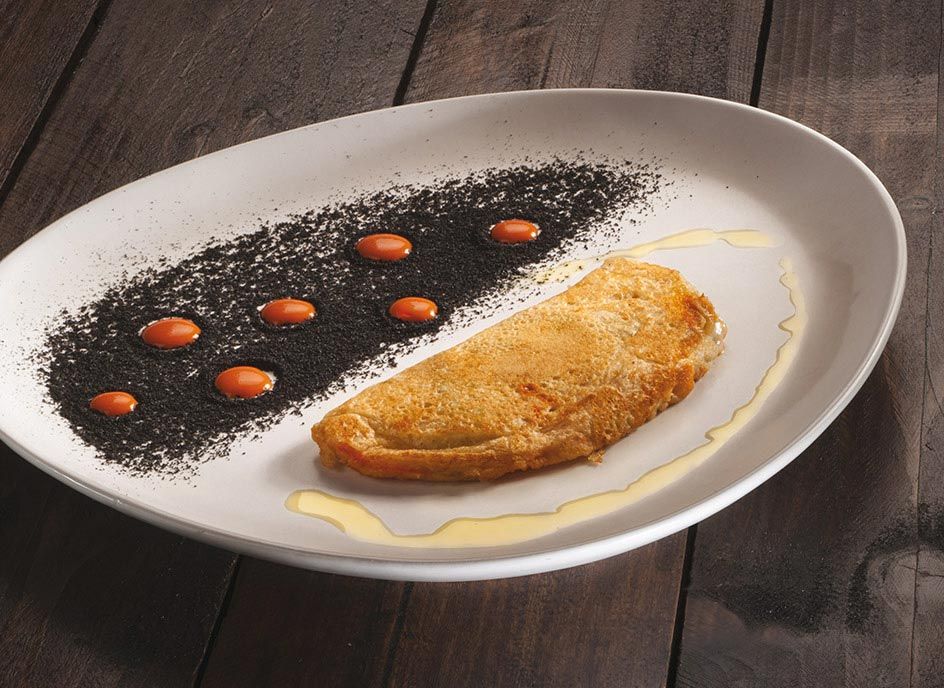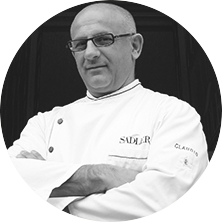
Main course, Soup
Whole Wheat flat bread stuffed with broccoli rabe, pecorino cheese & creamed cherry tomatoes.
Ingredients
Instructions
The dough:
In a large bowl, mix together both flours (sifted) with brewer’s yeast, adding the milk, eggs and beer and making sure not to let any lumps form. Let sit for about 2 hours at room tem- perature until the dough rises.
The filling:
Trim the broccoli rabe and boil it in a pot with a generous amount of salted water until nearly soft (about 10 minutes). Drain, let cool and then squeeze out any excess liquid. Cut the bacon into small strips – julienne – and fry until crisp in a non-stick pan. Add the broccoli rabe and flavored evo and sauté a few minutes, then set aside. Once cooled, add the pecorino cheese (diced), tossing the mixture and adding salt and pepper and a touch of ground chili pepper to taste.
Place the cherry tomatoes in a plastic microwaveable bowl with a pinch of salt, a clove of garlic (unpeeled), a shallot cut into pieces and three basil leaves. Add a trickle of evo oil, seal with plasticwrap and cook in the microwave on high for 15 minutes.
Remove from microwave and blend using an immersion mixer, then strain the sauce into a separate bowl, adding salt and pepper to taste.
Heat a small amount of evo oil in a non-stick 18cm skillet and pour in about 1/10 of the dough.
Let it thicken, then place some of the broccoli mixture on it and cover by folding over the other half of the flatbread. Remove from skillet.
Repeat this process for each flatbread, placing them on an oven tray lined with wax paper and lightly greased with evo oil.
Cook breads in the oven at 180°C for about 3-4 minutes. To serve: Grind pumpernickel bread through a sieve and cover each plate (pictured).
Make tiny depressions with your fingertips and fill them with the tomato sauce.
Trickle a few drops of sweet and delicate evo oil on top and lay the warm flatbread over it.
In a large bowl, mix together both flours (sifted) with brewer’s yeast, adding the milk, eggs and beer and making sure not to let any lumps form. Let sit for about 2 hours at room tem- perature until the dough rises.
The filling:
Trim the broccoli rabe and boil it in a pot with a generous amount of salted water until nearly soft (about 10 minutes). Drain, let cool and then squeeze out any excess liquid. Cut the bacon into small strips – julienne – and fry until crisp in a non-stick pan. Add the broccoli rabe and flavored evo and sauté a few minutes, then set aside. Once cooled, add the pecorino cheese (diced), tossing the mixture and adding salt and pepper and a touch of ground chili pepper to taste.
Place the cherry tomatoes in a plastic microwaveable bowl with a pinch of salt, a clove of garlic (unpeeled), a shallot cut into pieces and three basil leaves. Add a trickle of evo oil, seal with plasticwrap and cook in the microwave on high for 15 minutes.
Remove from microwave and blend using an immersion mixer, then strain the sauce into a separate bowl, adding salt and pepper to taste.
Heat a small amount of evo oil in a non-stick 18cm skillet and pour in about 1/10 of the dough.
Let it thicken, then place some of the broccoli mixture on it and cover by folding over the other half of the flatbread. Remove from skillet.
Repeat this process for each flatbread, placing them on an oven tray lined with wax paper and lightly greased with evo oil.
Cook breads in the oven at 180°C for about 3-4 minutes. To serve: Grind pumpernickel bread through a sieve and cover each plate (pictured).
Make tiny depressions with your fingertips and fill them with the tomato sauce.
Trickle a few drops of sweet and delicate evo oil on top and lay the warm flatbread over it.

LO CHEF: CLAUDIO SADLER
“Evolving modern cuisine”: this is probably the definition that best describes his cooking philosophy. Milanese by birth and in spirit, born in 1956, Claudio Sadler is now an internationally recognised chef, awarded no less than 2 Michelin Stars.
In his recipes he is always looking for harmony, simplicity and delicacy, in a careful balance between faithfulness to the traditions of regional Italian cooking and reinterpretations enhanced by a very personal creativity and artistic sensibility. This is made possible thanks to an approach which is at the same time methodical and open to innovation, based on sound skills and a strict application of rules.
The process for developing a new Claudio Sadler dish is long and complex: often months are needed before a dish becomes part of the chef’s menu. But once there, each new creation shows off a small masterpiece in taste and presentation.
In his recipes he is always looking for harmony, simplicity and delicacy, in a careful balance between faithfulness to the traditions of regional Italian cooking and reinterpretations enhanced by a very personal creativity and artistic sensibility. This is made possible thanks to an approach which is at the same time methodical and open to innovation, based on sound skills and a strict application of rules.
The process for developing a new Claudio Sadler dish is long and complex: often months are needed before a dish becomes part of the chef’s menu. But once there, each new creation shows off a small masterpiece in taste and presentation.
